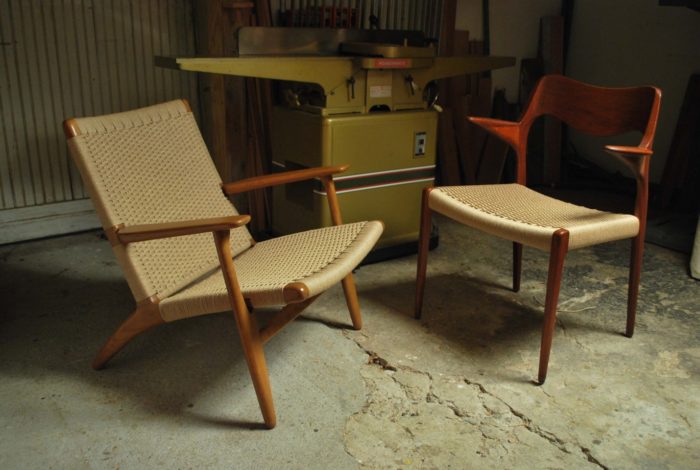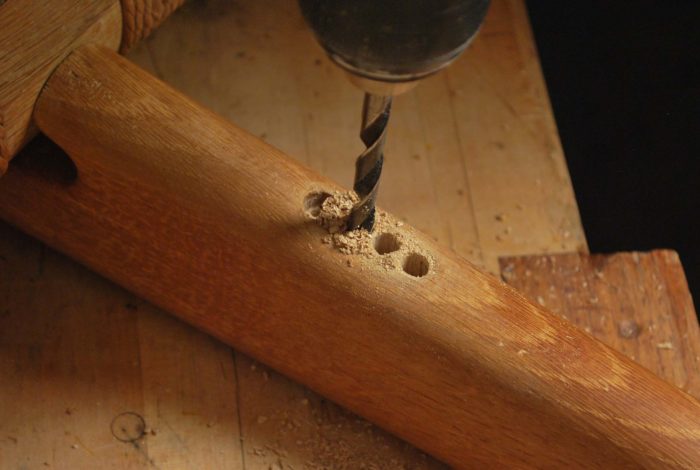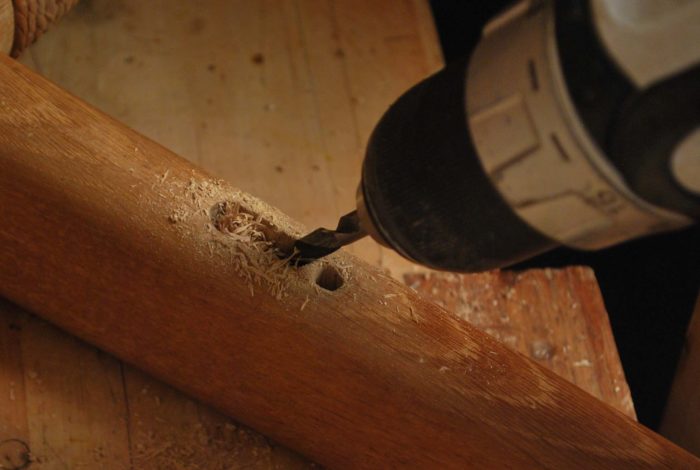Chair Repair: How to Fix a Broken Tenon
David Johnson repairs a broken tenon on a Mid-Century classic; a Hans Wegner CH25.

When I began repairing chairs as opposed to concentrating on making new pieces, I was often met with wrinkled noses from my woodworking peers. It’s understandable, since when you repair a piece you take on responsibility for the quality of someone else’s work. However, with many chairs coming and going through my shop, I get to study how different styles of chairs age and break. Two of the most common repairs I do on chair frames are broken tenons and dowels. Since chairs and repairs vary, use these methods as starting points and adapt them for your specific chair.

This post demonstrates my methods for fixing broken mortise-and-tenons. I’ll cover dowel joints in a follow-up post.

This Wegner chair failed where the tenon on the front stretcher meets the mortise in the front leg.

Start by removing the broken tenon from the front leg mortise by drilling out the waste with an undersize drill bit. If the break is jagged, roughly create a flat area so the bit won’t wander. Be careful how deep you drill; usually you’ll feel the drill bit finding the bottom of the mortise.

Continue to drill a series of holes and remove the bulk of the tenon by leveraging the bit back and forth in the mortise.

Next, chisel out the mortise. Carefully pare down the walls of the mortise to remove the glue and expose fresh wood. Only widen the mortise to fit the router bit you will use to cut the mortise in the rail.

Test the fit with thickness spacers. After being pared clean, this mortise in the leg was exactly 3/8 in. I stacked a 1/4-in. and a 1/8-in. spacer to test the mortise thickness.

Next cut a mortise in the rail exactly over the broken tenon. Typically, the break will be near the shoulder and I usually leave the jagged edge, especially if the tenon extends to the edges of the rail. This will help conceal the repair.
 |
 |
Make a spacer for the thickness of a shoulder. On this chair, the new tenon will be slightly larger than the original so I made the spacer a little thinner to compensate for half of the extra tenon thickness. I eyeball this but it’s important to get it right so the rail lines up exactly to its original location. Use this spacer to set the router bit off the reference surface for cutting the mortise in the rail.

Mark the rail and leg so you know which side you are registering against. As a rule, I usually reference off the insides. Set the depth of the mortise and the width to around 1/4 in. from the edges of the rail. Cut the mortise square to the shoulder.

Mill some tenon stock to thickness to fit the mortises but oversize in width. Mark the depth of the rail mortise on one end of the tenon stock and if the two mortises are of different widths, notch this end to fit over the broken tenon ends or to the shoulder, whichever is appropriate for your piece.
 |
 |
Round the end. I mark it with a shopmade template and trim it down with a chisel.

In this example, the side of the tenon that fits into the rail is a different width because the original tenon went all the way to the top and bottom of the rail. I notched the slip tenon to match the narrower mortise I made in the rail. Then I kept the slip tenon wide to match the original mortise in the leg.
 |
 |
With the tenon inserted into the rail, mark where it should be cut to match the leg mortise. For this chair the tenon extends to the top and bottom of the rail. After cutting it down, round the edges of the end that fits into the leg.

As always, dry-fit to check before gluing up.
-David Johnson specializes in the conservation of Danish Modern chairs with woven seats from his home shop in Los Angeles. He also produces original work and teaches weaving. You can find him on Instagram (@sidecar_furniture) and on his website, sidecarfurniture.com .
Fine Woodworking Recommended Products

Leigh D4R Pro

Suizan Japanese Pull Saw

Leigh Super 18 Jig








Comments
I get all that and I'm very intrigued how you do such an invisible, complex repair. What I want to know is how you put the newly repaired rail back in the chair, now that it's full length. Should I assume that the chair has to be disassembled so the full-length rail can fit between the two legs?
Yes, would love to know his techniques for disassembling the chair so he can reassemble it with the repaired stretcher. Hopefully, hide glue. A little water and/or vinegar? A hand-held heat gun? How does he do it without damaging the finish?
We'll make sure that gets covered in a post! David is going to be doing more of these!
On this chair both tenons were broken so the piece just came right off. The seat on a CH25 sits on two dowels which are always loose. I just lifted the seat up, held my breath, and flexed the front of the chair open enough to get the repaired tenon in.
If a joint is intact I generally leave it alone since undoing the glue causes more damage, and work. If it won’t come apart with a well planned and firm strike of a dead blow it deserves to stay together. More on that later...
That’s me David, AKA user 5258593. I was responding while waiting for my taco order and didn’t notice the username.
nice I have a broken Windsor style with a broken round so looking forward to your approach for dowels
wouldn't you know it. My Father in law asked me this weekend to fix his 40 year old chair that had a loosened front leg. I took it home and saw that it was originally a mortise and tenon, but someone had done a repair on it and used dowels and just cut and the the tenon in the mortise. I was thinking filling the dowel holes and using a domino to sink a couple slip tenons in.
I hope some of these methods I presented help you in your repair. I think a Domino would be an excellent solution if the tenon size works for your piece.
David Johnson
Almost all of what I do is repairing found pieces. I rescue damaged quality pieces from trash piles, repair them, and if my family don't need them I donate. So many pieces are out there that can have a new life.
Thank you for this guide on fixing tenons. I too have found multiple chairs needing such, and I'll do an even better job with this tip.
@D - I saw a tip on another site. Drill out the broken round, put in a new dowel of about the right size. If it ends up slightly too large, sand it. If slightly too small, wrap and glue a plane shaving about it.
Shh...you’re giving away some of my blog post ideas. ;)
David Johnson
Log in or create an account to post a comment.
Sign up Log in